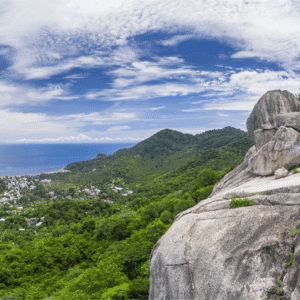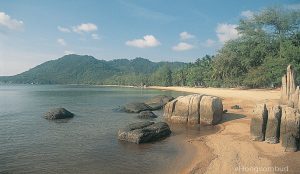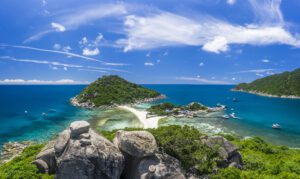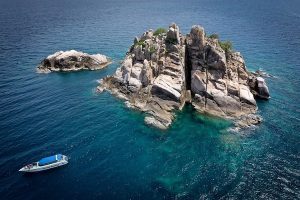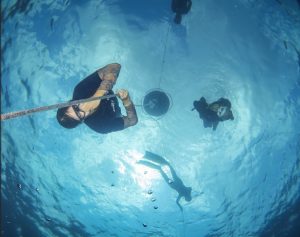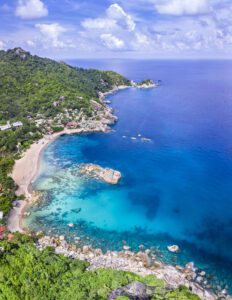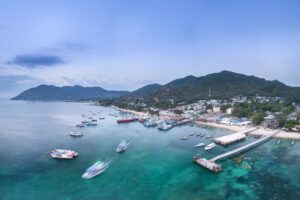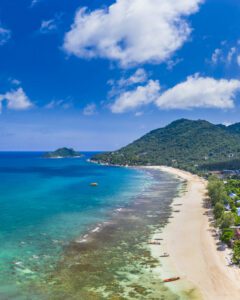Weather On Koh Tao
Weather on Koh Tao
One of the questions we are asked most regularly by our customers is what the weather on Koh Tao will be like during their stay, and indeed what will it be like throughout the year.
Like anywhere, temperatures, humidity, and rainfall will vary, and although the ambient air temperature only fluctuates by around 10°C annually. The humidity factor often makes it feel like it’s much hotter than it is. Water temperatures vary by around 8°C throughout the year. Even in extreme years (like El Nino cycles), you can expect the waters surrounding Koh Tao to be somewhere in the 26-34°C range.
Our temperate tropical waters are rich in marine life and attract many visitors each year, and even on a dull or rainy day the water temperature remains warm. In the tropics weather conditions can change quickly. Visitors should be aware that nothing is ever guaranteed when it comes to the weather on Koh Tao! Also, Thailand has an extremely regionalised set of microclimates, so do bear in mind that the weather on Koh Tao will not always be the same as at other destinations in the country – or even the neighbouring islands of Koh Phangan and Koh Samui.
For the vast majority of the year, the weather on Koh Tao is hot, sunny, and idyllic. Weather and diving conditions are subject to change though, so it’s worth a little planning to ensure your perfect stay can include all of the exploration and activities you want to do.
January – High Season
January is normally busy on Koh Tao as our winter high season starts in the last few weeks of December. Our island can become very busy between Christmas and New Year. The weather can be a bit unpredictable because in some years the monsoon rain and winds can linger. Visibility underwater is normally steadily improving and it is nice and warm back on land, but not too humid.
February – High Season
February is one of our favourite months! Warm and sunny on land but still not too humid. On the water we have calm seas and good diving conditions with visibility increasing even further from January.
March – Shoulder Season
The island quietens off a little in March, but the diving conditions remain excellent. Flat seas, great visibility, and also the start of ‘whale shark season’. We can never guarantee you’ll see whale sharks at any time of the year of course. Technically there is no guaranteed ‘season’ for them. But, historically March-April has been one of the better times. March also marks the start of the hot season, with humidity rising considerably.
April – Peak Season
We have a spike in our seasonal visitor numbers in April due to Songkran (Thai New Year) on the 13th. Joining the Songkran festivities is always memorable, lots of fun, and highly recommended! This is the hottest month of the year for weather on Koh Tao though, so don’t forget your sunscreen! For divers, whale shark sightings are still very likely in April, and the visibility is normally excellent.
May –Low Season
One of the quieter months and still quite hot, but with humidity dropping a little towards the end of the month. Scuba diving and snorkeling conditions remain optimal, with clear visibility and calm waters all around the island.
June – Low Season
June is one of the quietest months for visitor arrivals, so it is a great time to be here if you are looking for a more peaceful stay! Towards the end of the month, you may see some rain showers. While our wet season is still months away, we do get some kickbacks from the monsoon on the west coast that primarily affects areas such as Krabi, Phuket, Koh Lanta, etc. Diving conditions can drop a little as a result, and we can experience some waves out at sea.
July – Shoulder Season
July is a mixed month, with the first couple of weeks remaining fairly quiet. High season typically arriving from mid-month onwards. Humidity and air temperature on land have dropped by now, and while we can experience some choppy seas. A small decrease in visibility due to some rain showers is likely, however conditions are generally still good.
August – High Season
August is one of our busiest months, mainly due to the European summer holidays, and this is the most popular time for families. The weather on Koh Tao can be variable in August, with rain showers still prominent, although not normally extreme. Conditions at sea vary, and the tide is normally very low at this time of year, so dive site choices are often weather dependent during August.
September – High Season
Another of our favourite months! It is still peak season with lots going on, but things will have eased off a little since August. Any intermittent rain has normally stopped, dive conditions are better, and you have a good chance of spotting a big spotty fish as September marks the beginning of our second unofficial ‘whale shark season’.
October – Shoulder Season
Visitor numbers trail off as we progress through October, and dive conditions can be hit-and-miss but generally remain above average. Historically as we get towards the end of October, you could expect rain and some wind as monsoon season approaches. However, in recent years October has remained fair throughout, as our monsoon season seems to be pushing back somewhat due to climate change.
November – Low Season
You used to be able to set your watch by our monsoon season. The last week of October would see rain and wind, and for the entire month of November we’d plan for choppy seas, limited visibility, and lots of rainfall. In the last few years, however, the monsoon season has not arrived until later. Some years it isn’t as powerful as it used to be, and in other years it doesn’t arrive at all.
December – Shoulder Season
Quite often the new start to our monsoon season, December is quieter than it used to be and the high season doesn’t really get underway until later in the month. Conditions on land and at sea can be unpredictable depending on what monsoon has decided to do (or not!). Ambient temperatures are normally a bit cooler, so this tends to be one of the months when locals get the most use out of that one jumper they all have lurking at the back of their wardrobes somewhere!
The Thai Meteorological Department is the Thai Government Agency responsible for weather forecasting. Their website is excellent for delivering weather updates in the Gulf Of Thailand, particularly during stormy sea conditions.
